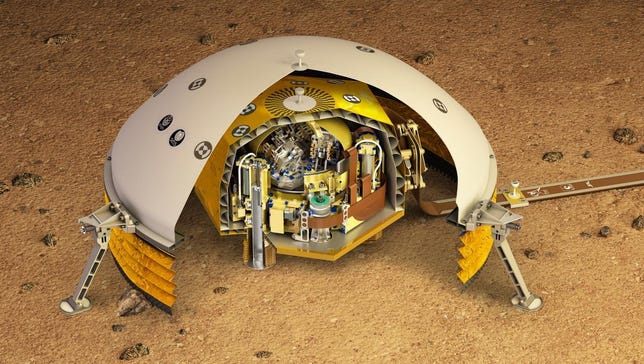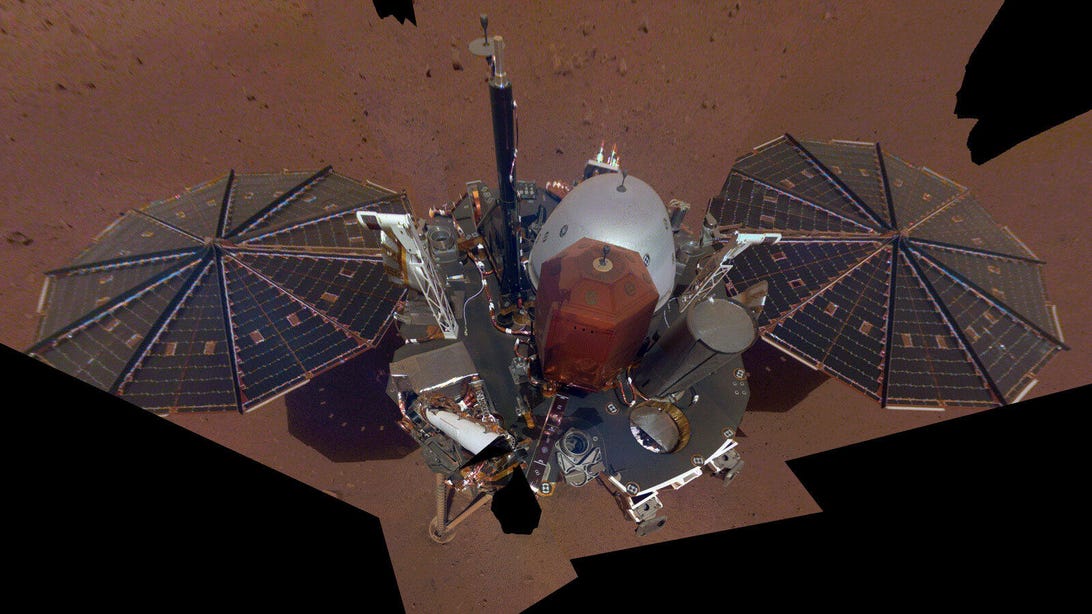When Galileo observed the planet Mars with a telescope over 400 years ago, it registered as little more than a blank orb, hanging in the infinite dark. In the four centuries since, scientists have attempted to fill in the blanks.
It wasn't long after Galileo that Dutch astronomer Christiaan Huygens came along and made a profound discovery about Mars. Observing the planet in 1659, Huygens noticed a large, dark area on its face, shading in a heart-shaped blotch in a sketch of the red planet. It was the first time humans had observed the surface features of another world.
Some 359 years later, in November 2018, NASA landed InSight on the Martian surface about 2,000 miles east of the blotch, the eighth time the space agency had put a robotic explorer on the red planet. Its mission, which was recently extended to 2022, is to listen for "marsquakes" and understand what's going on beneath the surface of our cosmic neighbor.
In a series of three studies published in the journal Science on Thursday, a global team of researchers describe the interior of Mars using data obtained by InSight's seismometer, an instrument that responds to vibrations and noise under Mars' surface. Analyzing a series of marsquakes, felt by InSight since 2019, researchers have been able to reveal the inner workings of another planet in our solar system for the first time -- a breakthrough for planetary geoscience.
Ear to the ground
The first planetary rattle detected by InSight's seismometer, known as SEIS, in 2019 was just like that first tentative drawing from Huygens. It revealed Mars was more seismically active than the moon, but not quite as active as Earth, and gave researchers a tantalizing first look at the kind of data InSight would be able to gather.

A cutaway of SEIS, a dome-shaped instrument that sits on the surface of Mars. The white outer layer shields the sensitive instrument from the environment, while the inner layer of organized chaos contains pendulums that measure vibrations and noise.
NASA/JPL-Caltech/CNES/IPGPSEIS (pictured right) is a dome-shaped instrument that was deployed shortly after InSight's arrival on Mars. It rests on the Martian soil and, as NASA says, is like a doctor's stethoscope, listening into the "pulse" of the planet. It's an extremely sensitive piece of tech, recording the seismic waves that rumble and vibrate through the planet's interior after a quake.
Its exterior dome is a shield against the Martian environment, protecting SEIS from the winds and dust that could affect measurements of internal vibrations. The seismometer itself is a rather simple device: it contains three weights, suspended like a pendulum, that can detect vibrations from different directions -- like when a seismic wave, generated by a marsquake, passes over them.
Previous research has shown that marsquakes are common, but they aren't very powerful. Only a handful register upward of magnitude 3 which, on Earth, might feel like a slight rumbling from a few miles away, but isn't quite strong enough to cause significant damage to structures and buildings. Most originate in the upper layer of the planet's crust, but the studies probed 10 that originated from deeper below the surface.
Listening to the waves generated by these quakes is how researchers came to understand Mars' innards. Seismic waves that move through the planet's interior are changed by the material they come into contact with -- allowing InSight to paint a picture of what's happening in the ground.
Ogres, onions and other planets
The anatomy of a "differentiated" planet like Mars is, to borrow from a 20-year-old film, just like an onion (...or an ogre). It has layers. Although scientists have filled in the blanks in regards to surface features, atmosphere and chemical composition of the soil, what's happening below the surface has been a mystery.
"For all we know about Mars -- most of it is limited to the top meter," says Gretchen Benedix, an astrogeologist at Curtin Unversity in Australia who was not affiliated with the study. "It's like looking at a present and focusing on the wrapping."
In the suite of new studies, researchers probed these layers for the first time by studying the waves that jiggled InSight's SEIS. "This new information is like opening the gift to take a peek," says Benedix.
One of the studies, led by Brigitte Knapmeyer-Endrun, a geophysicist at the University of Cologne, used the data to study the uppermost layer of the planet, known as the crust.
The upper layer of the crust, which is composed of basalt rock from ancient lava flows, seems to be at most around 10 kilometers (6.2 miles) thick. But InSight's data revealed that another layer, approximately double that size, lies just beneath it. Underneath that, Knapmeyer-Endrun said in a press release, might be where the "mantle" begins -- which would make Mars' crust "surprisingly thin."

A "selfie" of the InSight lander, taken on the surface of Mars.
NASA/JPL-CaltechBut the team also showed that there may be a third layer in the crust, extending the depth down to around 40 kilometers.
Then there's the Martian core, which threw up some surprises of its own.
As demonstrated in the image at the top, marsquakes can send vibrations all the way down to the planet's core, where they bounce off and fling back toward SEIS. These signals, as described in a study led by Simon Stähler, a geophysicist at ETH Zurich in Switzerland, were relatively faint but helped estimate how big the planet's core is. And size matters here.
The boundary between the mantle and the core seems to be a touch under 1,000 miles below the surface, which is larger than some studies have suggested. The suggestion, according to an accompanying piece published in Science on Thursday, is that the iron-nickel core is less dense than previously predicted, but is in a liquid state as other studies have argued.
Why does the inside of Mars matter?
The return of seismology to Mars was described by University of Texas geophysicist Yosio Nakamura as "a new dawn" in a Nature Geoscience commentary in 2020. The ability to detect seismic waves helps place some fundamental constraints on how the planet likely evolved over time and, according to Benedix, "tells us a lot about the thermal evolution of that planet."
Heat emanates from the core of a planet during its formation and early evolution and by understanding the composition of the core, researchers can hypothesize how Mars may have cooled over time. Combining this with other data, obtained by orbiting spacecraft and NASA's and China's rovers, doesn't just help us understand Mars -- it reveals how planets form, change and develop across the solar system and potentially outside it, too.
InSight also attempted to take a direct measure of the temperature below the surface of the red planet using a "burrowing mole." But early on, as the mole attempted to dig into Mars' crazy soil, it got stuck. Heroic attempts by NASA engineers to free the mole proved fruitless and, in January, it was declared dead. However, InSight's mission is not over -- it will continue listening for marsquakes into 2022. Though it only provides a single "ear," as it were, repeated observations should allow scientists to further refine their understanding of Mars' interior.
In less than four centuries, we've gone from Huygens sketch of a heart-shaped blotch on Mars' face to understanding the very heart of Mars itself. May the blanks continue to be filled in.
https://news.google.com/__i/rss/rd/articles/CBMiYmh0dHBzOi8vd3d3LmNuZXQuY29tL25ld3MvaW4taGlzdG9yaWMtZmlyc3QtbmFzYS1zcGFjZWNyYWZ0LW1hcHMtd2hhdC1sdXJrcy1iZWxvdy1zdXJmYWNlLW9mLW1hcnMv0gFtaHR0cHM6Ly93d3cuY25ldC5jb20vZ29vZ2xlLWFtcC9uZXdzL2luLWhpc3RvcmljLWZpcnN0LW5hc2Etc3BhY2VjcmFmdC1tYXBzLXdoYXQtbHVya3MtYmVsb3ctc3VyZmFjZS1vZi1tYXJzLw?oc=5
2021-07-24 01:47:22Z
52781745890367
Tidak ada komentar:
Posting Komentar